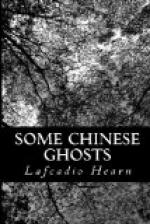[Illustration: Decorative motif]
Glossary
[Illustration: Chinese calligraphy]
GLOSSARY
ABHIDHARMA.—The metaphysics of Buddhism. Buddhist literature is classed into three great divisions, or “baskets”; the highest of these is the Abhidharma.... According to a passage in Spence Hardy’s “Manual of Buddhism,” the full comprehension of the Abhidharma is possible only for a Buddha to acquire.
CHIH.—“House”; but especially the house of the dead,—a tomb.
CHU-SHA-KIH.—The mandarin-orange.
CRAMANA.—An ascetic; one who has subdued his senses. For an interesting history of this term, see Burnouf,—“Introduction a l’histoire du Buddhisme Indien.”
DAMARI.—A peculiar chant, of somewhat licentious character, most commonly sung during the period of the Indian carnival. For an account, at once brief and entertaining, of Hindoo popular songs and hymns, see Garcin de Tassy,—“Chants populaires de l’Inde.”
DOGS OF FO.—The Dog of Fo is one of those fabulous monsters in the sculptural representation of which Chinese art has found its most grotesque expression. It is really an exaggerated lion; and the symbolical relation of the lion to Buddhism is well known. Statues of these mythical animals—sometimes of a grandiose and colossal execution—are placed in pairs before the entrances of temples, palaces, and tombs, as tokens of honor, and as emblems of divine protection.
FO.—Buddha is called Fo, Fuh, Fuh-tu, Hwut, Fat, in various Chinese dialects. The name is thought to be a corruption of the Hindoo Bodh, or “Truth,” due to the imperfect articulation of the Chinese.... It is a curious fact that the Chinese Buddhist liturgy is Sanscrit transliterated into Chinese characters, and that the priests have lost all recollection of the antique tongue,—repeating the texts without the least comprehension of their meaning.




